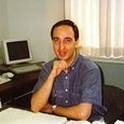
We investigate, design, and develop a prototype real-time synchronous receiver for the second-generation quantum communicator recently developed at the National Aeronautics and Space Administration (NASA) Glenn Research Center. This communication system exploits the temporal coincidences between simultaneously fired low-power laser sources to communicate at power levels several orders of magnitude less than what is currently achievable through classical means, with the ultimate goal of creating ultra-low-power microsize optical communications and sensing devices. The proposed receiver uses a unique adaptation of the early-late gate method for symbol synchronization and a newly identified 31-bit synchronization word for frame synchronization. This receiver, implemented in a field-programmable gate array (FPGA), also provides a number of significant additional features over the existing non-real-time experimental receiver, such as real-time bit error rate (BER) statistics collection and display, and recovery and display of embedded textual information. It also exhibits an indefinite run time and statistics collection. (c) 2009 Society of Photo-Optical Instrumentation Engineers.
